Renewable sources of energy such as solar or wind are not only clean but are also the cheapest form of power generation in most of the markets. Increased use of these sources reduce the overall greenhouse gas emissions and have a better impact on the health of living beings. However, several challenges need to be addressed before shifting completely towards the use of the renewable sources of energy.
The future of mankind and industry is now dependent on renewable energy, which is also good for the environment and the society. The world is focused on increased use of clean energy sources and is already undertaking various steps to promote clean and green renewable sources of energy to meet their power needs.
It is said that renewable energy can supply two-thirds of the total global energy demand and contribute to the reduction of greenhouse gas emissions that is required to limit average global surface temperature increase below two degrees Celsius.
Carbon emissions have escalated over the past few decades as society has utilised a high amount of traditional forms of energy that is generated from fossil fuels. Renewable energy or green energy plays an imperative role in reducing the world’s carbon emissions, and it is now very high on the international agenda. Most importantly, renewable energies and renewable technologies are not only clean, these are also the cheapest form of power generation in most of the markets.
Meanwhile, the growing digital world, smart devices, and smart grids have become a boon to people because these have opened the door to the market. For instance, households equipped with roof-top solar systems can feed any surplus electricity they generate into the grid, thereby acting as both producers and consumers of energy.
Other households are using smart meters to adjust their consumption in line with the current market price or time of the day. As per International Renewable Energy Agency (IRENA), renewable energy needs to be scaled up at least six times faster for the world to meet the goals set out in the Paris agreement.
Amod Anand, co-founder, Loom Solar, says, “The decline in renewable energy costs, improved energy efficiency, new technologies, and well-informed policy-making can definitely create a sustainable energy future within reach. Certainly, there are obstacles in reaching the benchmark. Global warming is a huge concern for environmentalists and leaders of the world currently. Most renewable energy sources produce little to no global warming emissions. Increasing the supply of renewable energy also allows replacing carbon-intensive energy sources and significantly reducing global warming emissions.”
“Governments and associations across the globe are taking steps to potentially increase the inexhaustible sources of energy—wind and solar. Several initiatives are being taken to expand their ambitions to get rid of fossil fuels in heating, cooling, transport, and industry. Clean energy also reduces harmful smog, a toxic build-up in the air we breathe and water we consume, and the impacts caused by coal mining and gas extraction. By replacing our fossil-fuel infrastructure and building stronger renewable energy generation, we can create a sustainable energy future and reduce the impact on climate change,” he adds.
According to the Indian startup Loom Solar, a ‘decade of adoption’ for the global transition to renewable energy was scheduled to commence in 2020. Most of the segments were definitely struck by the pandemic that has taken the wind out of their sails. There has been some progress in the transition, according to the 2019 Renewables Global Status Report from REN21, a leading think tank on renewable energy. The majority of new electricity production is in renewable energy format. Promises to decarbonise renewable energy and oil have been made by around more than 160 nations.
The international conversion to clean energy
Today, governments of all the countries are reacting to the economic effects of the pandemic by introducing unprecedented steps, but they are also neglecting the major issues like energy and climate. India ranks third over renewable energy expenditure and plans, as per a new study by British Business Energy. In the meantime, renewable energy is expected to almost double in India by 2022.
According to the Renewables Global Status Report (GSR), worldwide carbon emissions are not reducing fast enough. Second, the international subsidies to fossil fuels were about eleven per cent between 2016 and 2017 that reached 300 billion dollars in a year. The report also revealed that the total investment in renewable energy was about 288.9 billion dollars in 2018, which is far less than the subsidies provided to fossil fuels.
The shifting of renewable energy in the electricity sector has escalated, and globally more and more renewable energy capacity has been installed rather than new nuclear and fossil fuel capacity. Around 181GW of new renewables capacity was installed in 2018, which is now more than one-third of the worldwide installed power.
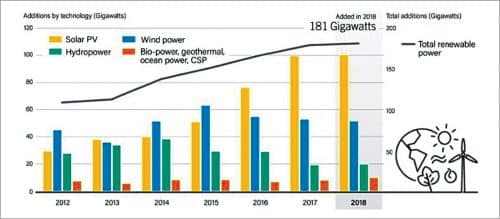
Fig. 1 clearly explains that biopower and wind power are somewhat stable, but hydropower energy is quite down. It is because renewable capacity additions are primarily growing in solar PV panels. If we count all the major renewable energy capacity installed globally in 2018, 55 per cent (about 100GW) was solar PV, wind power was 28 per cent, and hydropower 11 per cent.
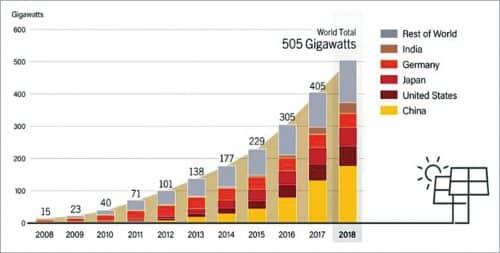
When it comes to energy installations, China is still ahead of most of the developed nations (Fig. 2). Back in 2018, it recorded the highest investment in renewable energy installation and is spearheading the world in terms of installed capacity of hydropower, solar PV, and wind.
During the Covid-19 lockdown period, the demand for other uses of renewable energy has declined, but renewable electricity is unaffected. Renewable energy in the form of biofuels reduced in Q1 2020 because the consumption of blended fuels for road transport fell.
According to experts, the total worldwide utilisation of renewable energy would increase by only one per cent in the year 2020. Despite global supply chain disruptions that have delayed industrial activity in several key regions, the expansion of wind, hydropower, and solar is expected to help augment renewable electricity generation to five per cent by the end of 2020.
In Q1 2020, as per iea.org, the global use of renewable energy was 1.5 per cent higher than in Q1 2019. The increase was driven by a rise of about three per cent in renewable electricity generation after more than 100GW of solar PV and about 60GW of wind power projects were completed in 2019.
Iea.org further reported that the share of renewables in global electricity generation jumped to nearly 28 per cent in Q1 2020 from 26 per cent in Q1 2019. The increase in renewables came mainly at the cost of coal and gas, though those two sources still represent close to sixty per cent of global electricity supply. In Q1 2020, variable renewables—in the form of solar PV and wind power—reached nine per cent of generation, up from eight per cent in Q1 2019.
Renewable energy is the fastest-growing energy source in the United States, increasing 100 per cent from 2000 to 2018, and it made up more than 17 per cent of net US electricity generation in 2018, with the bulk coming from hydropower (7.0 per cent) and wind power (6.6 per cent).
Around eighteen percent of the energy consumed globally for heating, power, and transportation was from renewable sources in 2017. Nearly sixty percent came from modern renewables (biomass, geothermal, solar, hydro, wind, and biofuels) and the remainder from traditional biomass (used in residential heating and cooking in developing countries). Renewables made up 26.2 per cent of global electricity generation in 2018. That’s expected to rise to 45 per cent by 2040. Most of the increase will likely come from solar, wind, and hydropower.
Growth of renewable energy in India
Our nation’s renewable energy generation increased to 5.22 per cent in first eight months of the previous financial year (April-November 2019), the lowest rate of growth in the past four years since 2015-16, according to fresh data sourced from the Central Electricity Authority (CEA). CEA’s monthly executive summary report of November 2019 showcased combined generation from solar, wind, small hydro and biomass and bagasse-based power plants stood at 93.69 billion units in the April-November period.
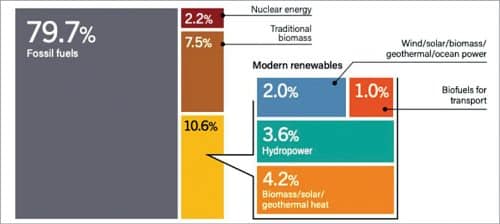
India now ranks fourth in wind power, fifth in solar power and fifth in renewable power installed capacity as of 2018, and it posted a CAGR of 17.33 per cent between FY 2016-2020. As a part of its Paris Agreement commitments, the government has set an ambitious target of achieving 175GW of renewable energy capacity by 2022 (Fig. 3). This includes 100GW of solar capacity addition and 60GW of wind power capacity.
Government plans to establish a renewable energy capacity of 500GW by 2030. According to the government trust India Brand Equity Foundation (IBEF), the installed renewable energy capacity stood at 87.26GW, of which solar and wind comprised 34.81GW and 37.74 GW, respectively, as of April 2020. In 2019, India installed 7.3GW of solar power across the country, establishing its position as the third-largest solar market in the world.
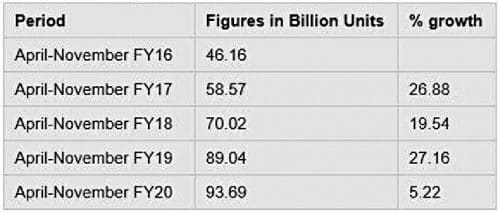
Challenges of installing renewable energy
Though the sector poses several benefits to society and industry, it also poses a lot of challenges. The solar energy segment has a bright future and holds immense potential for our economy. However, the lack of clear policies and regulations that can promote the implementation of renewable energy technologies is impeding the larger adoption in this segment. The market in renewable energies requires consistent policies and legal procedures to increase investor interest.
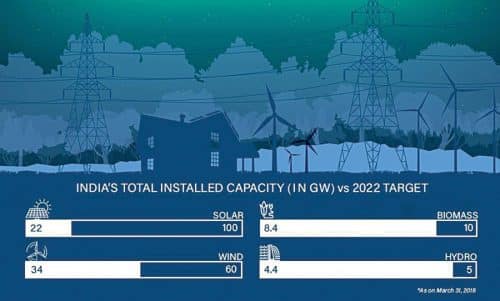
Lack of knowledge and understanding of renewable energy technologies and systems among rural communities is another challenge faced in the growth of renewable energy. Initial resources, implementation costs, economic status, and the availability of incentives and subsidies are the key factors influencing the pace of adoption of renewable energy technologies.
It is being witnessed that renewable energy’s initial investment cost is much higher when compared to other traditional energy sources. This remains a major obstacle to sustainable renewable energy solutions being put into practice.






